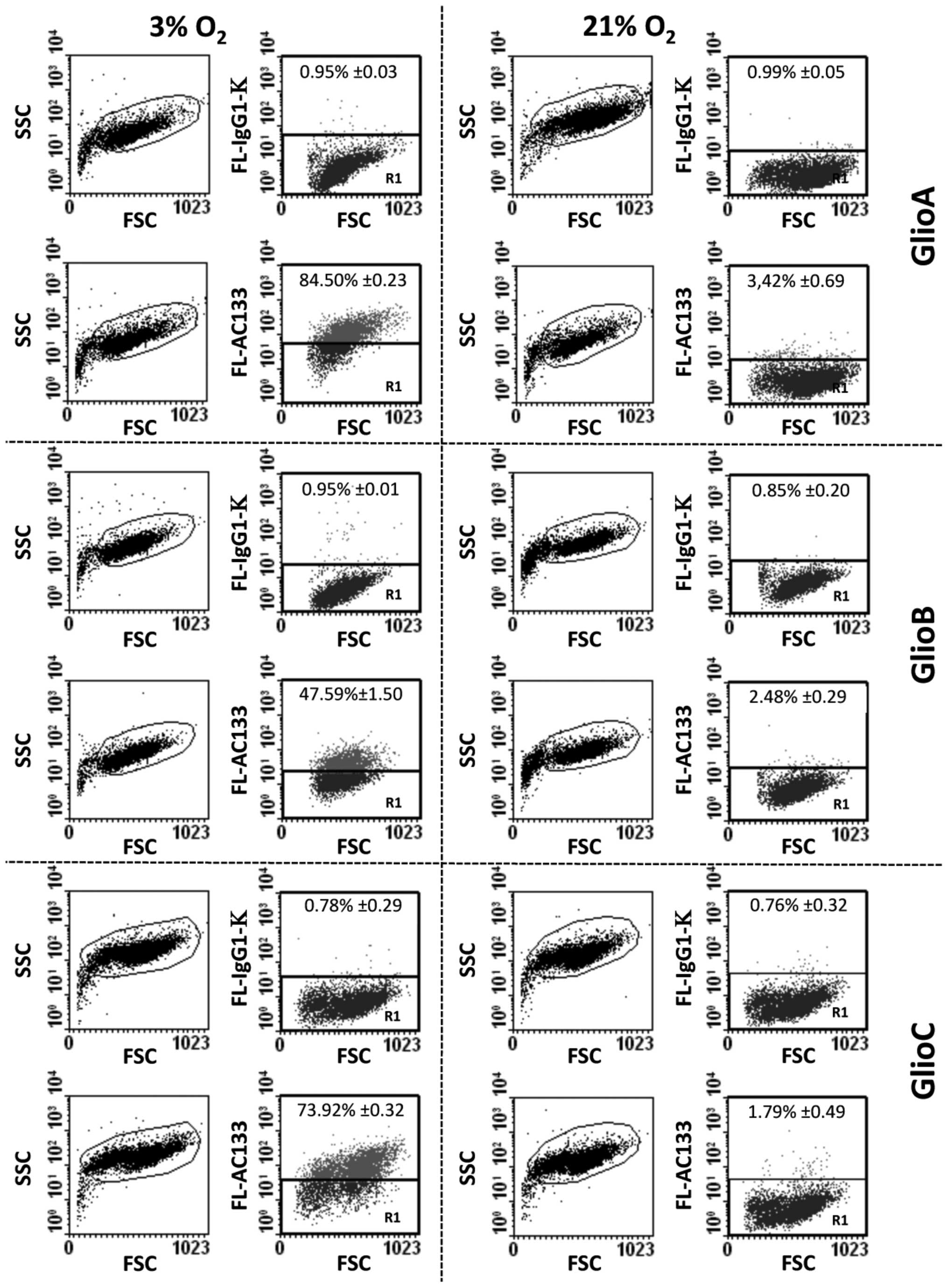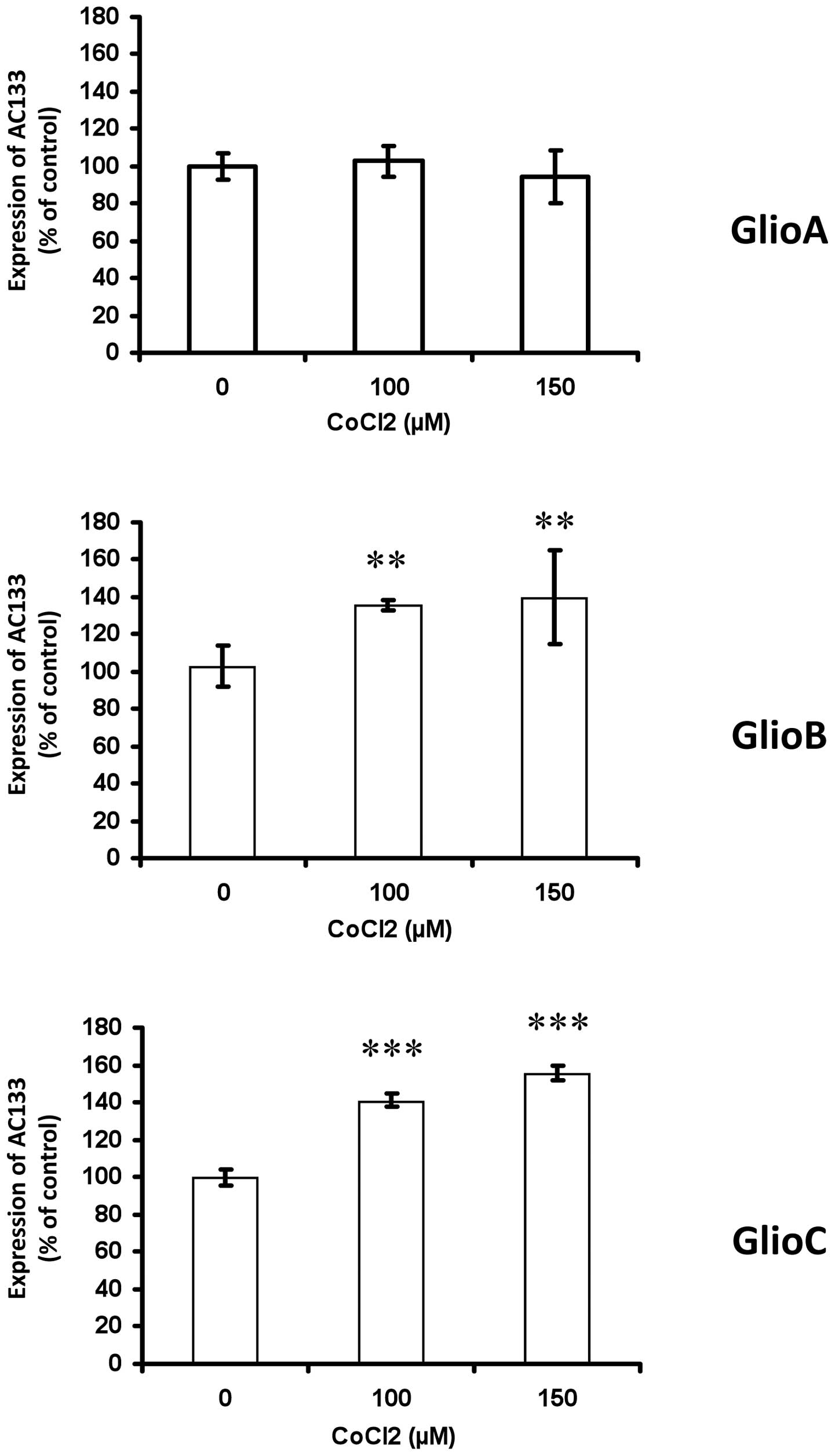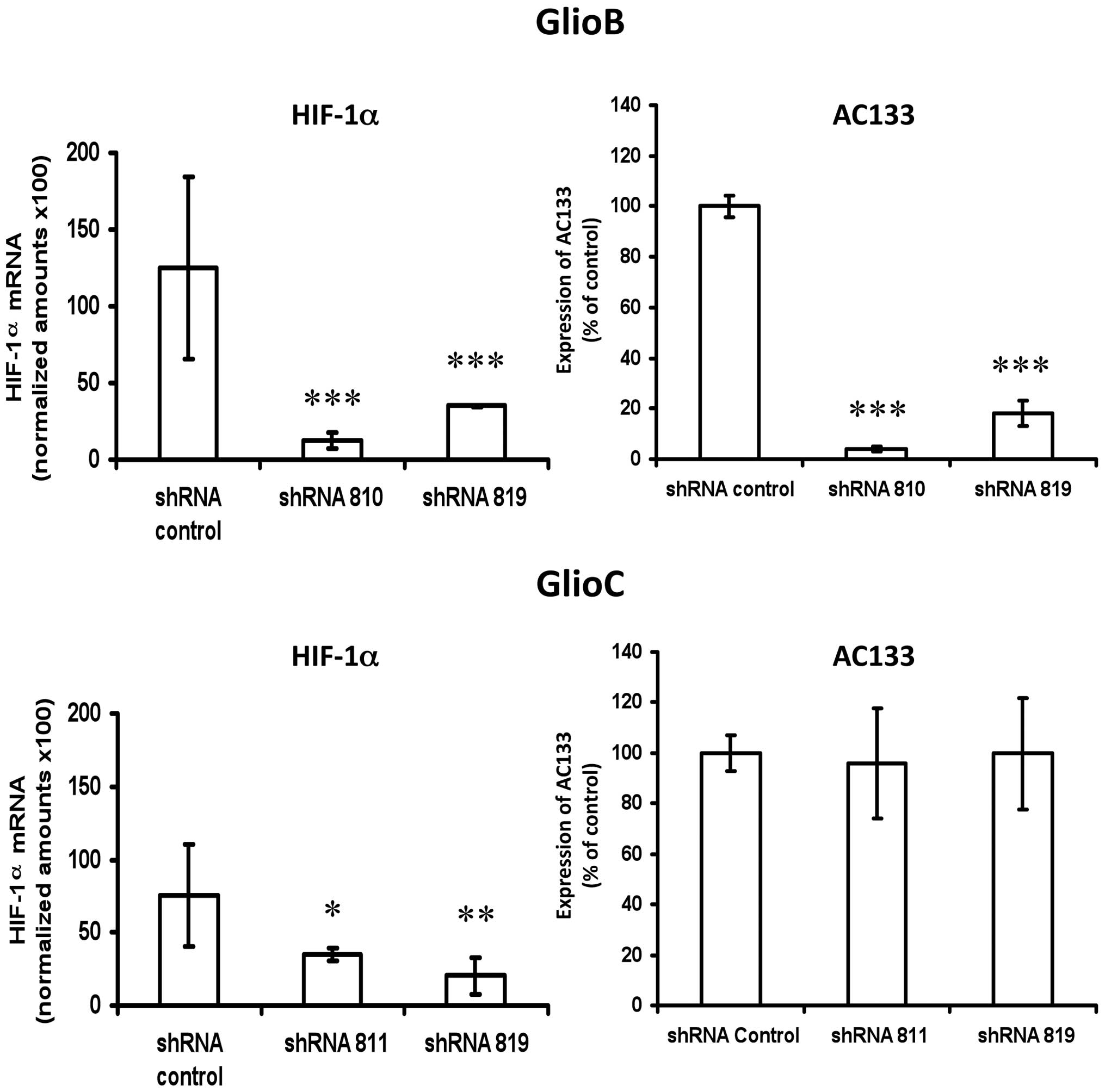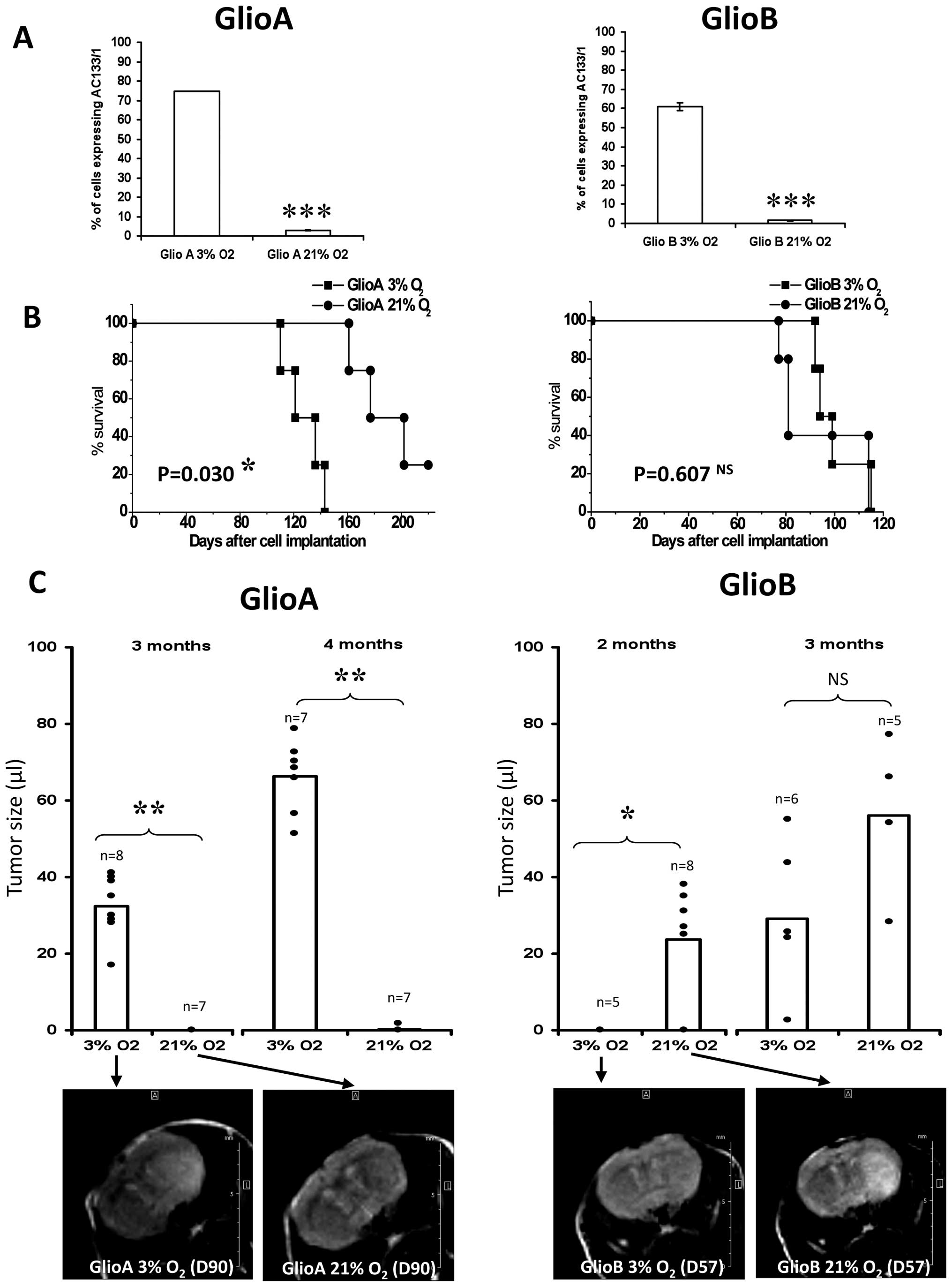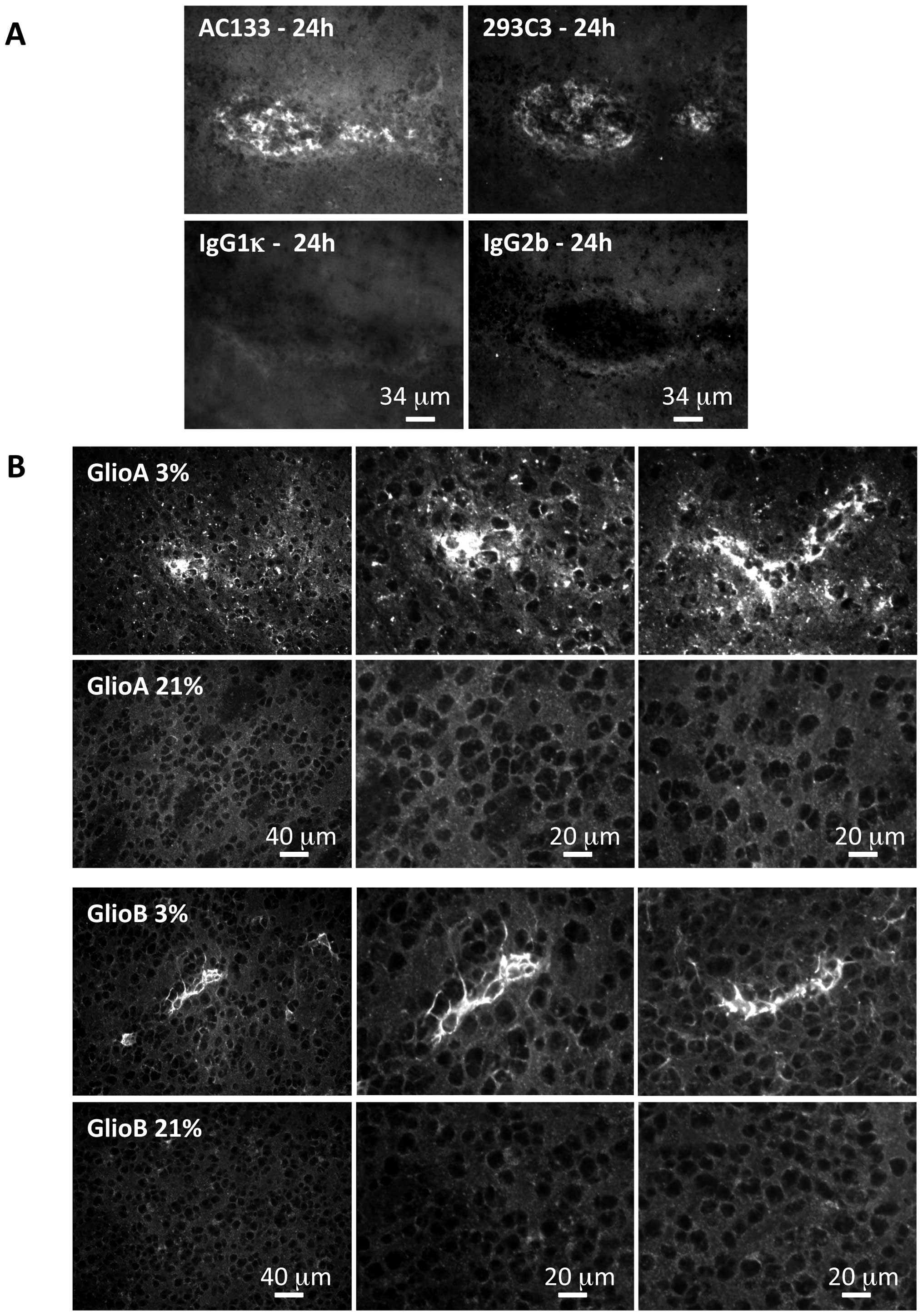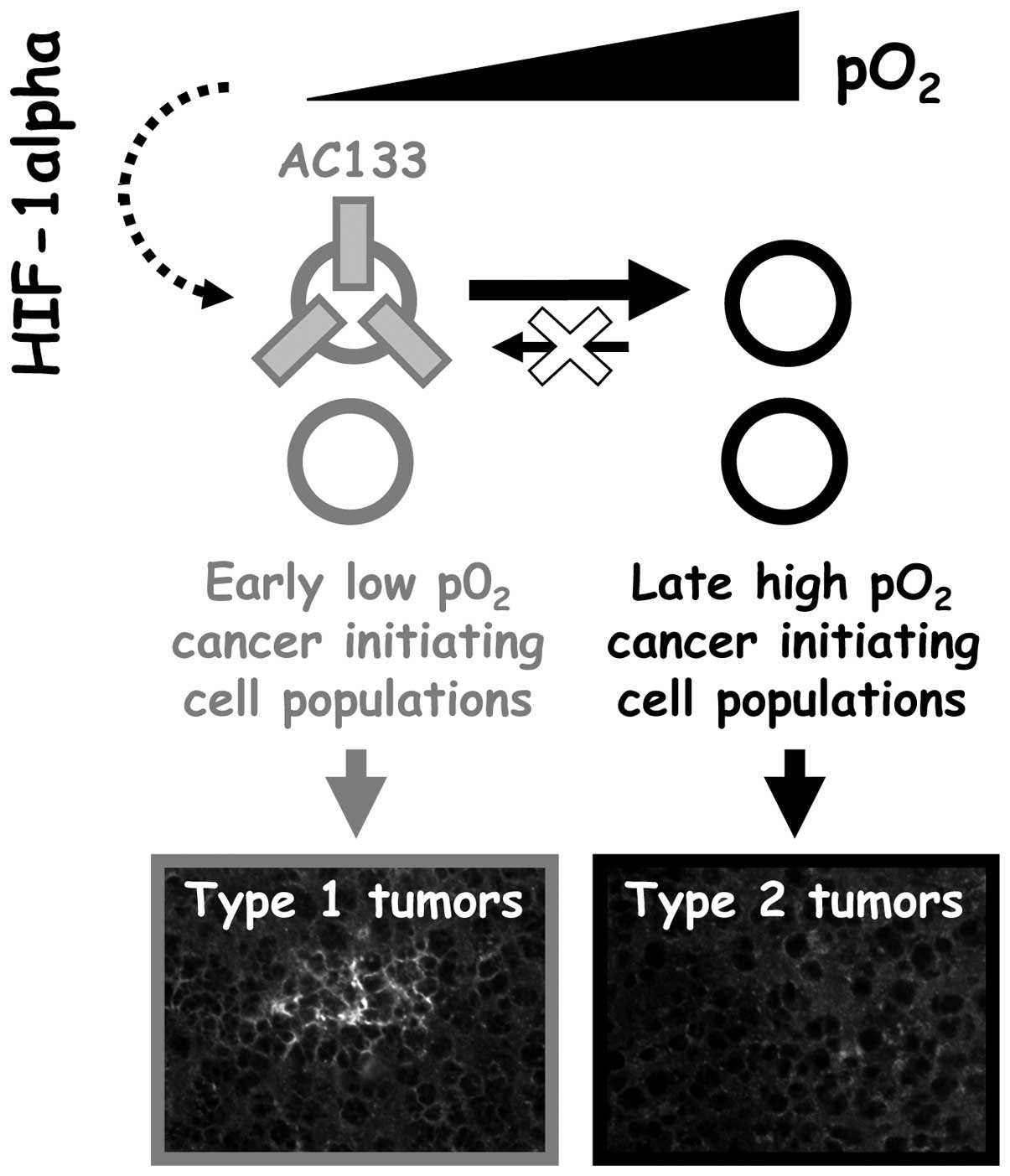In vitro expansion of human glioblastoma cells at non-physiological oxygen tension irreversibly alters subsequent in vivo aggressiveness and AC133 expression
- Authors:
- Published online on: November 23, 2011 https://doi.org/10.3892/ijo.2011.1271
- Pages: 1220-1229
Abstract
Introduction
Central nervous system glioblastomas are among the most aggressive and treatment-resistant cancers. The recent discovery of self-renewing and uniquely tumorigenic brain tumor stem cells (BTSCs) (1–4), also referred to as brain cancer initiating cells, points to the presumption that this cancer stem cell subpopulation intrinsically resistant to radio and chemotherapeutic treatments might be responsible for the phenotypical derivation of tumors and their recurrence.
Instead of specific markers, makers shared with cancer stem cells (5,6) and BTSCs, such as AC133 (2), CD15 (7), and CD171 (8), have been documented. Among these, AC133, an epitope of the CD133 protein, which is itself a pentaspan glycoprotein identified firstly on hematopoietic stem cells, is the best known (9–12). In vitro, in the presence of EGF, FGF-2, and heparin, AC133 expressing cells isolated from human glioblastoma regenerate, form neurosphere-like colonies and are capable of generating cells that express markers of differentiated neural cells (2). In xenograft models using immunodeficient mice, they lead to cancers that are phenotypically similar to the original tumors (2). AC133-positive cancer cells are also particularly resistant to radiotherapy (13) and TRAIL-mediated apoptosis (14). In addition, these cells are capable of promoting tumor neovascularization by producing VEGF (15). Finally, AC133 overexpression in human gliomas is associated with poor clinical outcome (16).
Although these findings are in line with the relevance of developing targeted strategies against BTSCs in glioblastomas through AC133 recognition, other observations argue for a more complex reality. Indeed, while less tumorigenic than their AC133-positive counterparts (3), AC133-negative cells can lead to tumors with a distinct phenotype (17). Moreover, the occurrence of BTSCs does not exclude the existence of cellular networks in which individually non-tumorigenic cell populations might cooperate to produce tumors (18). In addition, the tissue microenvironment might exert pivotal effects for tumor development (18,19), and extrinsic cell modulators may drive the expression of intrinsic markers.
In line with this, AC133 expression in glioblastoma has been associated either with anatomical while not necessarily functional perivascular niches (20) or hypoxic pseudopalissading necrotic regions (21,22). Thus, it is not yet understood whether AC133 incidence in those areas is due to improved survival of AC133-positive cells or positive regulation of AC133 expression. As oxygen is involved in the stem cell behavior (23) and tumor aggressiveness of human glioblastoma (24), it is important to consider its role on AC133 expression and AC133-positive BTSC performance. As such, it has recently been demonstrated that exposure to low oxygen tension (pO2) allows for maintenance of the AC133 phenotype of non-sorted human glioblastoma cells in vitro (25). In addition, sorted AC133-positive human glioblastoma cells preserve their stem cell phenotype under low oxygen tension in vitro (26).
Nonetheless, these studies did not address how cell culture pO2 might affect the AC133 phenotype and the behavior of cancer cells following implantation in animals. In our study, we demonstrate that xenogenic experimental tumors, obtained from non-sorted human glioblastoma cells cultured either at 3 or 21% O2, can significantly differ. In this context, we investigate whether AC133 is an indicator of low oxygen tension or of tumor aggressiveness. Finally, we discuss our data regarding the relevance of biopsy-derived models for functional investigations or for therapeutic targeting purposes.
Materials and methods
Patient tissue samples and human glioma cell cultures
Specimens from patients undergoing biopsy for de novo glioma were obtained from the Department of Neurosurgery of the Angers CHU (France), and from the Department of Neurosurgery of the Grenoble CHU (France), with institutional review board approvals. Pathologic diagnosis established that GlioA, GlioB, and GlioC tumor samples were grade IV WHO glioblastomas. Straight after tissue dissociation as previously described (25), cells were plated on uncoated plastic flasks at 2×104/ml of defined medium and cultured at 37°C under an atmosphere containing 5% CO2 and either 3 or 21% O2. GlioA, GlioB and GlioC were cultured in Dulbecco’s modified Eagle’s medium: Nutrient Mixture F-12 (DMEM/F12, Biowhittaker, Verviers, Belgium) added with Glutamax, B27 and N2 supplements (Invitrogen, Cergy Pontoise, France), recombinant human EGF and FGF-2 (20 ng/ml each, R&D Systems Europe, Lille, France), and heparin (5 μg/ml, Sigma-Aldrich, Lyon, France). Growth factors and supplements were added every 3 days for a period of 10–15 days, until new dissociations with Versene (Lonza, Levallois-Perret, France) and re-plating following initial culture setting. Under these permanent conditions, cells grew and were maintained as floating neurosphere-like colonies.
AC133 labeling and flow cytometry
Glioma cells exposed to different oxygen tensions were collected and dissociated using Versene (Lonza). A total of 1.5×105 cells were incubated with 5 μg/ml AC133 antibody (Miltenyi Biotech, Paris, France) or IgG1 isotype control (BD-Biosciences, Le Pont-de-Claix, France) for 1 h at 4°C in PBS containing 5% FBS and 0.02% sodium azide. Cells were then washed three times in PBS containing 5% FBS and 0.02% sodium azide, and incubated for 30 min at 4°C with FITC-conjugated goat anti-mouse IgG F(ab’)2 fragment polyclonal antibody (Dakocytomation, Trappes, France) at 20 μg/ml in PBS containing 5% FBS and 0.02% sodium azide. Following three more washes in PBS containing 5% FBS and 0.02% sodium azide, cells were re-suspended in PBS containing 2% formaldehyde and 0.02% sodium azide. A BD FACSCalibur™ fluorescent-activated flow cytometer and the BD CellQuest™ software (BD-Biosciences) were used in order to proceed to flow cytometry acquisition. Analysis was carried out using WinMDI 2.9 software (Scripps Institute, La Jolla, CA, USA).
Treatment of human glioma cells with cobalt dichloride (CoCl2)
GlioA, GlioB, and GlioC human glioblastoma cells were dissociated in Versene (Lonza). They were then plated at 37.5×105 cells per ml in the aforementioned media and incubated in the presence of vehicle alone (PBS) or 100–150 μM CoCl2 for 24 h at 37°C, 5% CO2 and 3% O2.
shRNA knockdown
Glioblastoma cells were stably transfected using control transduction particles (SHC001V) or shRNA transduction particles expressing siRNA against HIF-1α (IDs: TRCN0000003810, TRCN0000003811 and TRCN0000010819), according to the manufacturer’s instructions (Mission® pLKO.1-puro lentiviral particles, Sigma-Aldrich). Cells were seeded at 5×103 in 96-well plates in supplemented neurobasal medium, and infected with a multiplicity of infection of 2. Puromycine (1 μg/ml, Sigma-Aldrich) selected infected cells.
Q-PCR
Q-PCR analyses were carried out using a Chromo 4™ (Bio-Rad, Marnes-la-Coquette, France) and SYBR Green detection (iQ-SYBR Supermix, Bio-Rad). Primers were designed using Primer3 software (http://frodo.wi.mit.edu/primer3/). The ΔCt method was retained for quantification, and multiple genes were used for normalization, as previously described (27).
Orthotopic xenograft assays
GlioA and GlioB human glioblastoma cells, grown at 3 or 21% O2, were dissociated in Versene, washed, and resuspended at 50,000 cells in 5 μl Eagle’s minimum essential medium (EMEM, Biowhittaker). SCID female mice (Charles River) were anesthetized using xylazine (50 μg/g) (Rompun®, Bayer, Puteaux, France) and Ketamine (10 μg/g) (Clorketam®, Vétoquinol, Lure, France). Stereotactic implantation of the 5 μl cell suspension was carried out into the right striatum using a Hamilton syringe and a 32-gauge needle at the following coordinates: 0.5 mm anterior from Bregma, 2 mm lateral from the saggital suture, and 3 mm below dura. Cells were injected progressively over 2.5 min, followed by 5 min of waiting, and progressive needle removal from brain over 6 min. MRI was used to monitor tumor growth. The Kaplan-Meier method was used to plot animal survival. Animal care was carried out in line with relevant European Community regulations (Official Journal of European Community L358 12/18/1986).
Magnetic resonance imaging
Experiments were performed with a Bruker Avance DRX 300 (Bruker, Wiessembourg, France), equipped with a vertical super wide bore magnet and shielded gradient insert. The resonant circuit of the nuclear magnetic resonance (NMR) probe was a 38-mm diameter birdcage. Rectal temperature was maintained at 37°C by using a feedback-regulated heating pad. Brain lesion evolution was assessed using T2-weighted images obtained using a rapid acquisition with relaxation enhancement (RARE) (TR = 2000 ms; effective echo time = 31.7 ms; RARE factor = 8; FOV = 2.5 × 2.5 cm; matrix 128×128; nine contiguous slices of 1.2 mm, four averages). In order to improve tumor detection, FLAIR imaging was performed using a 600 ms inversion pulse prior to the RARE pattern, providing enough time to allow for the annulling of the normal parenchyma and therefore tumor detection.
Immunohistochemistry
Brains from xenotransplanted mice were surgically removed, snap-frozen in isopentane cooled at −35°C with liquid nitrogen, and stored at −80°C before 10 μm transverse sections of anterior brain were made using a Cryocut 3000 (Leica, Rueil-Malmaison, France). After at least 24 h storage at −20°C and 30 min drying at room temperature, slides were fixed in −20°C cold methanol for 10 min. Sections were then blocked with 10% normal goat serum in PBS added with 4% bovine serum albumine for 30 min at room temperature. Primary antibodies against CD133 (clone AC133 and clone 293C3 both from Miltenyi Biotech) and the corresponding negative isotype controls (mouse IgG1κ and mouse IgG2b, both from BD Biosciences) were diluted in PBS containing 4% BSA and used at 5 μg/ml. They were applied overnight at 4°C. After washes in PBS, a secondary biotinylated goat anti-mouse IgG antibody (Vector Laboratories, Burlingame, USA) diluted in PBS containing 4% BSA was applied at 15 μg/ml for 45 min at room temperature. After additional washes in PBS, Alexa Fluor® 488 streptavidine conjugates (Invitrogen, Cergy Pontoise, France) were applied in the dark at 4 μg/ml for 45 min. Finally, labeled sections were washed three times with PBS before mounting in fluorescent mounting medium from Dakocytomation. All slides were examined under an Axioskop-2 Zeiss fluorescence microscope (Le Pecq, France). Images were acquired through a Photometrics CoolSNAP ES camera equipped with a QImaging CRI Micro Color 2 RGB Liquid Crystal filter and by using the MetaVue™ imaging system (all from Roper Scientific, Evry, France).
Statistical analysis
XLSTAT 2006 Version 2006.3 (Addinsoft Paris, France) was used for data analysis. Statistical significance for each experiment was determined by a Dunnett’s test. Alternatively, the Gehan-Wilcoxon and the Mann and Whitney non-parametric tests were used. The tests were considered as significant with p<0.05.
Results
Oxygen tension impacts the AC133 phenotype of human glioma cells in vitro
To determine the effect of oxygen pressure on AC133 expression in non-sorted primary human glioblastoma cells, GlioA, GlioB, and GlioC were cultured either at 3% O2 or 21% O2. High expression of AC133 was found in all cell lines when maintained at low oxygen tension (from initial suspensions to at least passage 30). As such, at matching cell passages flow cytometry analysis revealed that the percentage of AC133-positive cells was improved from 3 to 21% O2 condition (Fig. 1). Quantification of geomean fluorescence intensity further indicated a mean reduction of AC133 expression per cell up to 99% between 21 and 3% O2 (Table I).
Table IGlioblastoma cells cultured at low pO2 expressed improve levels of AC133 than those cultured at high pO2.a |
A role for HIF-1α in the regulation of AC133 expression
Having established a role for oxygen tension in the regulation of AC133, we next investigated whether HIF-1α a major transcription factor regulated by oxygen tension, was involved in this effect. HIF-1α has been described to be over-expressed in various cancers including gliomas (28). It heterodimerizes with constitutively expressed subunit HIF-1β to form HIF-1, a basic helix-loop-helix structure that regulates the transcription by specifically recognizing a short consensus HRE (hypoxia responsive element) sequence in the promoter of hypoxia responsive genes. HRE sequence is characterized by the presence of a consensus core CGTG found in all known HIF-1α-responsive promoters (29). A multiple sequence alignment ClustalW2 program revealed that the consensus core was present in all CD133 promoters from P1 to P5. Interestingly, the analysis showed that a sequence of 12 nucleotides present in P5 (known to be functional in stem cells) TACGTGCTCTGG-nucleotides 5416–542 matched perfectly with that present in the [+656/+667] HRE sequence of the human IGFBP-1 gene (30). Hence, this sequence represents a potential target for the binding of HIF-1 in glioblastoma cells.
To determine the potential influence of HIF on regulating the expression of AC133, cobalt chloride (CoCl2), which inhibits the degradation of HIF (31), and the shRNA knockdown strategy against HIF-1α were used. As HIF-1α stabilization has been shown to increase from moderate to severe hypoxia while not induced under ambient air (32), in order to try getting its level maximal, the hypoxia-mimetic CoCl2 was used already from the 3% O2 condition. When GlioA cells were incubated for 24 h with 100 or 150 μM of CoCl2 in low pO2 conditions, no significant change was observed in AC133 expression as compared to control culture (Fig. 2). In contrast, CoCl2 treatment increased the expression of AC133 in GlioB and GlioC (+36–41% for GlioB and +41–56% for GlioC) (Fig. 2). We further address the impact of HIF-1α inhibition on CoCl2 responding glioblastoma cell types. Transcriptional down-regulation of HIF-1α mRNA with a lentiviral shRNA-based system performed on GlioB (knockdown efficency of ~80% and GlioC (knockdown efficiency of ~65% (Fig. 3 left panels) was associated with a 80–90% reduction in AC133 expression for GlioB, but had no impact on AC133 expression for GlioC (Fig. 3 right panels).
Human glioma cells exposed to different oxygen tensions in vitro do not behave equally following orthotopic transplantation in immunodepleted mice
Having established a role for oxygen tension and HIF-1α in regulating AC133 in vitro, we wished to further address whether tumor development and AC133 expression were affected by the expansion of human glioblastoma cells under different oxygen tension culture conditions. For this purpose, we focused on the cell types for which tumors were detected through MRI monitoring within 3 months after stereotactic injection of glioblastoma cells in the right striatum of immunodepleted mice, namely GlioA and GlioB (Fig. 4). Kaplan-Meyer curves shown in Fig. 4A revealed that GlioA cell cultures at 3% O2 were more aggressive than GlioA cells cultured at 21% O2. In contrast, no significant differences in Kaplan-Meier curves were observed on GlioB. However, tumors caused by the implantation of GlioA cultured at 3% O2 prior to injection were detected earlier than the tumors arising from GlioA cultured under 21% O2 (Fig. 4B). Indeed, mice injected with the cells cultured at 3% developed a detectable tumor within 3 months post-injection (average tumor size 32±8 μl (n=8)], whereas a similar size was observed 5 months post-injection of GlioA cells initially cultured at 21% O2.
Interestingly, although no differences were observed on Kaplan-Meier curves, GlioB cultured at 21 vs. 3% O2 appeared to differ on MRI images. When GlioB cells were cultured in vitro at 21% O2 prior injection, brain tumor occurred within 2 months [average tumor size 23±13 μl (n=8)], whereas injection of cells cultured at 3% O2 reached such a size after 3 months [average tumor size 34 ± 21 μl (n=6)] (Fig. 4B). Examined together, the data indicate that culture conditions are likely to exhibit a real impact on tumor aggressiveness in vivo, underlying the fact that the choice of culture parameters can modulate cell behavior in vivo.
Extinction of AC133 expression of human glioma cells exposed to low oxygen tension in vitro prevents in vivo re-expression after orthotopic transplantation in immunodepleted mice
In order to address human AC133 expression in mice with tumor growth, a study was carried out on mice 24 h post-injection of AC133 positive cells to validate AC133 immunohistochemical detection using the AC133 antibody or 293C3 antibody, both recognizing two different human epitopes of the CD133 protein (Fig. 5A).
Applying this technique to brain tumors collected at the end point of the experiment revealed that when the injected cells were initially cultured at 3% O2, AC133 was still detected, and this for both GlioA and GlioB cells (Fig. 5B). However, AC133 was detected in limited clusters within the tumor, suggesting that not all the tumor cells had kept the AC133 phenotype. The same approach on tumors arising from cells cultured at 21% O2 did not reveal any AC133 expression (Fig. 5B), indicating that neither GlioA nor GlioB cells grown in 21% O2 before injection gave rise to AC133 cells in vivo.
Discussion
Consequences of the 21% standard pO2 culture condition on glioblastoma phenotypes
To address cancer cell behavior in vivo and in vitro, cancer cell cultures are generally performed under 5% CO2 combined to classical atmospheric conditions of approximately 21% O2 (160 mm Hg). However, pO2 values do not exceed 12% O2 (95 mm Hg) in the blood and vary from 1 to 5% (6–34 mm Hg) in normal tissues including the brain (33). Moreover, a characteristic feature of advanced solid tumors is to display hypoxic tissue areas (pO2 ≤0.4% or 2.5 mm Hg) due to insufficient vascularization, oversize tumor mass, and necrosis (34). Thus, an atmosphere containing 21% O2 should be physio-logically considered hyperoxic. In the present study, although glioblastoma cells were cultured as three-dimension neurospheres, a condition that lowers pO2 due to the gradient of O2 diffusion from the external to the inner part of the spheres, our data demonstrated that in vitro pO2 ranges obtained at 3 versus 21% O2 resulted in distinct cell behavior in vivo. Tumor aggressiveness was higher for GlioA when cultured at 3 versus 21% O2. MRI detection of GlioB grown at 3% was delayed when compared to GlioB grown at 21%, while ultimately giving rise to similar adverse clinical effects. Moreover, AC133, typically found on fresh human glioblastoma biopsy specimens (21) or on short-term primary glioblastoma cultures [(3,13); our study]; was maintained after expansion in vitro at 3% O2 while lost at 21% O2 and not re-expressed after cell implantation in vivo. These combined findings stressed that pO2 values obtained at 3% O2 preserve better the AC133 phenotype of glioblastoma cells than do pO2 values obtained through the standard O2 atmospheric tension. Our results confirmed, therefore, that a low pO2 (≤3% O2 or 24 mm Hg) should be considered a basic condition to study glioblastoma cell behavior in their current microenvironment. As such, the fact that pO2 irreversibly changes the phenotype of glioblastoma cell populations is also reminiscent of the effects of serum and laminin on gene expression profiles, expression of stem cell makers, and glioma invasiveness (3,35,36). As variations of pH, the traditional 21% O2 represents a new environmental stress for glioblastoma cells that inevitably triggers alterations of their differentiation, genetic and epigenetic status, and survival. Considering tumor heterogeneity, selection of glioblastoma cell clones will therefore be different at 3 and 21% O2. As such, low oxygen tension is often perceived as an obstacle for chemo- and radiotherapy due to the induction of several resistance genes (13,36), DNA repair or methylation (22), miRNA expression (37), and maintenance of stemness (38). Conversely, high oxygen tension represents an oxidative stress that may be associated with the selection of cells that are well-equipped for reactive oxygen species detoxification (39).
Is AC133 a marker of BTSC non-chronic exposure to high oxygen tension?
AC133 has initially been described as a marker of hematopoietic stem cells (9,11), while then associated with embryonic stem cells (40) and a variety of somatic stem cells (41). AC133 was also recognized as a putative cancer stem cell marker in blood, brain, colon, prostate, lung, breast, liver, and skin cancers (12,41). Although the BTSC hypothesis was strongly supported by recent data (4,42,43), the idea of a responsibility of cancer stem cells in glioblastoma development remains to be documented (44) and does not exclude the role of clonal selection (45). We emphasize that if the hypothesis of brain cancer initiating cells is correct, the loss of AC133 does not preclude their occurrence. We did establish that GlioA and GlioB that do not contain high AC133 expressing cells when cultured at 21% O2 self-renew in vitro and do form tumors in vivo. The data give further significance to the originally established unique ability of immunosorted AC133-positive cells to form brain tumors (2,3,13,46) and corroborate the fact that AC133-negative cells are also capable of doing so (47,48). Thus, high AC133 expression is not a marker of every cancer initiating cells within brain tumors.
Sorted AC133-positive cells have been described as more aggressive than their AC133-negative counterparts (2,3,13). Our data proved that when considering the full cancer cell population, the major reduction in AC133 expression at high versus low pO2 (87.6%, GlioB, Table I) as well as in AC133 positive cell numbers (from 47.59 to 2.48%, GlioB, Fig. 1) allows for the development of tumors that are similarly aggressive. Thus, AC133 does not appear to be a general marker of tumor aggressiveness.
Low oxygen tension was associated with the stem cell-like properties of AC133-positive glioblastoma cells (26). As we have confirmed here that this also resulted in high levels of AC133, one might assume that AC133 expression constitutes a witness of low oxygen tension. The presence of putative HRE in Prominin-1 promoters combined with the modulation of AC133 expression by CoCl2 treatment and HIF-1α shRNA knockdown supported this assertion. Previous data obtained with siRNA against HIF-1α (49), or instead with an oxygen stable HIF-1α construct (50), also corroborated this, with a significant role for HIF-1α. Interestingly, in contrast to what happen in glioblastoma, in gastric, colorectal and lung cancer cell lines Matsumoto et al established an inverse correlation between HIF-1α and CD133 expression thus indicating tissue specificities for the regulation of CD133 by HIF-1α (51). However, CoCl2 did not induce AC133 in GlioA O2, and HIF-1α shRNAs were not able to reduce AC133 expression in GlioC. Although constitutive expression of AC133 might be maximal in GlioA, and HIF-2 is likely to compensate for the loss of HIF-1α in GlioC (21,52), HIF-independent pathways may be involved in the AC133 regulation by hypoxia. A variety of these recognizable cell signals that translate to environmental O2 changes have already been described, including: reactive oxygen species (53), thiol-based sensors (53), the transcriptional co-activator PGC-1α (54), or mTOR inhibition via the AMPK/TSC2/Rheb pathway (55). Regardless of the signaling pathway involved in regulating AC133 by pO2, we have established in our study that the loss of AC133 at 21% O2 in vitro (data not shown) and in vivo following glioma cell implantation in mouse brains was irreversible. This lack of re-expression of AC133 therefore supported the fact that AC133 is not a genuine marker of hypoxia in glioblastoma. Indeed, low pO2 commonly involved in glioblastoma growth and aggressiveness (23,24) should be present within GlioA and GlioB tumors, which was supported by a reduced vascularization observed using CD31 labeling (data not shown). One-way regulation of AC133 by pO2 might be explained by the acquisition of a new pattern of transcriptional activators or a new DNA methylation status of glioblastoma cells at 21% (56,57).
As AC133 does not attest to the glioma cell capability of forming tumors or to glioblastoma aggressiveness or low oxygen tension, we propose that it represents a witness of glioblastoma cell non-exposure to high oxygen tension. The presence of AC133 positive glioblastoma cell populations that have also been established at ambient oxygen setting could be explain in this context by creation of hypoxic gradients within the growing glioma spheres (58). This fact would be attenuated by chronic exposure of cells to high oxygen tension through sequential dissociation and re-plating. Hence, similarly to developmental cues that lead to irreversible maturation of early-to-late neural stem cell differentiation during development such as FGF (59), high oxygen tension may represent a component of the BTSC niche that drives an early-to-late BTSC switch during gliomagenesis. If EGF receptor expression represents a witness of the acquired phenotype for neural stem cell maturation, loss of AC133 would be a witness of BTSC maturation. To support this assertion, the loss of AC133 expression has been associated with cancer stem cell differentiation in glioblastoma (60) and in colon cancer (61). Moreover, use of glioma cell differentiation factors such as retinoic acid lead to down-regulation of AC133 expression (62). In addition, transdifferentiation of tumor cells into vessel formation was recently associated with stemness phenotype and hypoxia in glioblastoma (63). Thus, irreversible AC133-loss may also have an impact on this epithelial to mesenchymal transition reciprocally. Two types of tumors could therefore be obtained from non-sorted human glioblastoma cells expanded in vitro: type 1 tumors obtained from 3% O2-expanded cells (expressing AC133) and type 2 tumors obtained from 21% O2-expanded cells (no AC133 expression) (Fig. 6).
In conclusion, our present study underlines that non-physiological oxygen tension alters subsequent in vitro expansion and in vivo development of non-sorted human glioblastoma cells. With the preservation of AC133 expression, which can result from the prevention of AC133-positive cell death or from continuous prominin-1 gene expression, the 3% O2 expansion condition mirrors much the biological reality. Thus, the timing of environmental pO2 variations likely reflects a changing pattern of plasma membrane protein expression during glioblastoma growth that is associated with cell heterogeneity and resistance. The fact AC133 was here associated with an early glioblastoma phenotype suggests that identification of downstream cancer initiating cell markers as well as evaluation of relative anticancer drug sensitivity of type I and type II tumors (Fig. 6) would also be helpful in the development of anti-glioblastoma strategies.
Acknowledgements
We would like to thank Catherine Guillet, Julien Daligault, and Laurence Preisser (Service Commun de Cytométrie et d’Analyse Nucléotidique, SCCAN, Angers, France) for their skillful technical support. We are also grateful to Pierre Legras and Jérôme Roux from the Service Commun d’Animalerie Hospitalo-Universitaire (SCAHU, Angers, France). La Ligue Nationale Contre le Cancer ‘Equipe Labellisée 2007’ and Le Cancéropôle Grand-Ouest throughout the ‘Réseau Gliome Grand-Ouest’ (REGGO) and the ‘Axe Cellules Souches et Cancer’ supported this work. Erika Bourseau-Guilmain was a fellow of the Conseil Général de Maine-et-Loire and the Ligue Nationale Contre le Cancer. We also acknowledge the Comité Départemental de Maine-et-Loire de la Ligue Contre le Cancer.



